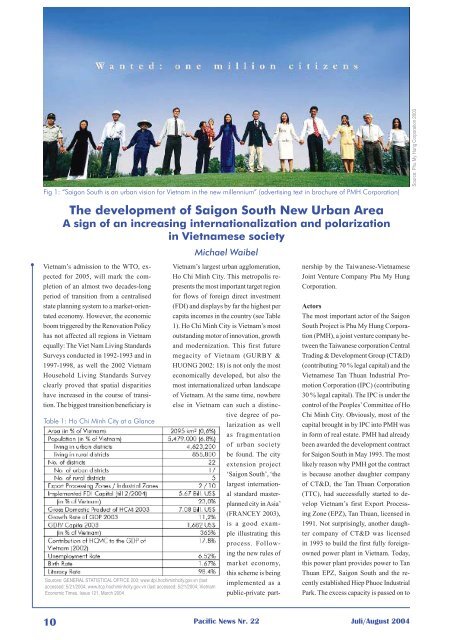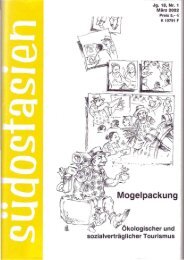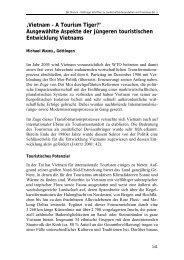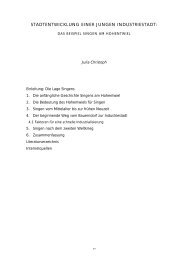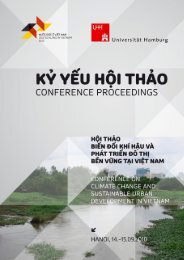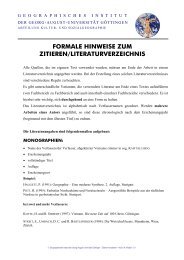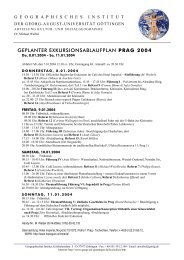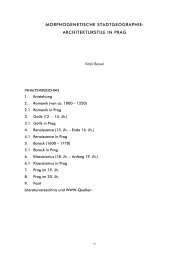The development of Saigon South New Urban Area - Dr. Michael A ...
The development of Saigon South New Urban Area - Dr. Michael A ...
The development of Saigon South New Urban Area - Dr. Michael A ...
Create successful ePaper yourself
Turn your PDF publications into a flip-book with our unique Google optimized e-Paper software.
Fig 1: “<strong>Saigon</strong> <strong>South</strong> is an urban vision for Vietnam in the new millennium” (advertising text in brochure <strong>of</strong> PMH Corporation)<br />
<strong>The</strong> <strong>development</strong> <strong>of</strong> <strong>Saigon</strong> <strong>South</strong> <strong>New</strong> <strong>Urban</strong> <strong>Area</strong><br />
A sign <strong>of</strong> an increasing internationalization and polarization<br />
in Vietnamese society<br />
Vietnam’s admission to the WTO, expected<br />
for 2005, will mark the completion<br />
<strong>of</strong> an almost two decades-long<br />
period <strong>of</strong> transition from a centralised<br />
state planning system to a market-orientated<br />
economy. However, the economic<br />
boom triggered by the Renovation Policy<br />
has not affected all regions in Vietnam<br />
equally: <strong>The</strong> Viet Nam Living Standards<br />
Surveys conducted in 1992-1993 and in<br />
1997-1998, as well the 2002 Vietnam<br />
Household Living Standards Survey<br />
clearly proved that spatial disparities<br />
have increased in the course <strong>of</strong> transition.<br />
<strong>The</strong> biggest transition beneficiary is<br />
Table 1: Ho Chi Minh City at a Glance<br />
Sources: GENERAL STATISTICAL OFFICE 200; www.dpi.hochiminhcity.gov.vn (last<br />
accessed: 5/21/2004; www.itcp.hochiminhcity.gov.vn (last accessed: 5/21/2004; Vietnam<br />
Economic Times, Issue 121, March 2004<br />
<strong>Michael</strong> Waibel<br />
Vietnam’s largest urban agglomeration,<br />
Ho Chi Minh City. This metropolis represents<br />
the most important target region<br />
for flows <strong>of</strong> foreign direct investment<br />
(FDI) and displays by far the highest per<br />
capita incomes in the country (see Table<br />
1). Ho Chi Minh City is Vietnam’s most<br />
outstanding motor <strong>of</strong> innovation, growth<br />
and modernization. This first future<br />
me gacity <strong>of</strong> Vietnam (GURBY &<br />
HUONG 2002: 18) is not only the most<br />
economically developed, but also the<br />
most internationalized urban landscape<br />
<strong>of</strong> Vie t nam. At the same time, nowhere<br />
else in Vietnam can such a distinctive<br />
degree <strong>of</strong> polarization<br />
as well<br />
as fragmen tation<br />
<strong>of</strong> urban society<br />
be found. <strong>The</strong> city<br />
extension project<br />
‘<strong>Saigon</strong> <strong>South</strong>’, ‘the<br />
largest international<br />
standard masterplanned<br />
city in Asia’<br />
(FRANCEY 2003),<br />
is a good example<br />
illustrating this<br />
process. Following<br />
the new rules <strong>of</strong><br />
market economy,<br />
this scheme is being<br />
implemented as a<br />
public-private part-<br />
nership by the Taiwanese-Vietnamese<br />
Joint Venture Company Phu My Hung<br />
Corporation.<br />
Actors<br />
<strong>The</strong> most important actor <strong>of</strong> the <strong>Saigon</strong><br />
<strong>South</strong> Project is Phu My Hung Corporation<br />
(PMH), a joint venture company between<br />
the Taiwanese corporation Central<br />
Trading & Development Group (CT&D)<br />
(contributing 70 % legal capital) and the<br />
Vietnamese Tan Thuan Industrial Promotion<br />
Corporation (IPC) (contributing<br />
30 % legal capital). <strong>The</strong> IPC is under the<br />
control <strong>of</strong> the Peoples’ Committee <strong>of</strong> Ho<br />
Chi Minh City. Obviously, most <strong>of</strong> the<br />
capital brought in by IPC into PMH was<br />
in form <strong>of</strong> real estate. PMH had already<br />
been awarded the <strong>development</strong> contract<br />
for <strong>Saigon</strong> <strong>South</strong> in May 1993. <strong>The</strong> most<br />
likely reason why PMH got the contract<br />
is because another daughter company<br />
<strong>of</strong> CT&D, the Tan Thuan Corporation<br />
(TTC), had successfully started to develop<br />
Vietnam’s first Export Processing<br />
Zone (EPZ), Tan Thuan, licensed in<br />
1991. Not surprisingly, another daughter<br />
company <strong>of</strong> CT&D was licensed<br />
in 1993 to build the first fully foreignowned<br />
power plant in Vietnam. Today,<br />
this power plant provides power to Tan<br />
Thuan EPZ, <strong>Saigon</strong> <strong>South</strong> and the recently<br />
established Hiep Phuoc Industrial<br />
Park. <strong>The</strong> excess capacity is passed on to<br />
10 Pacific <strong>New</strong>s Nr. 22 Juli/August 2004<br />
Source: Phu My Hung Corporation 2003
Fig 2: Masterplan <strong>of</strong> <strong>Saigon</strong> <strong>South</strong><br />
the national grid and currently satisfies<br />
about 45% <strong>of</strong> Ho Chi Minh City’s electricity<br />
demand (FRANCEY 2003). Altogether,<br />
the CT&D group has invested<br />
over 700 million US$ in the three interlinked<br />
projects mentioned above.<br />
Overview <strong>of</strong> <strong>Saigon</strong> <strong>South</strong><br />
<strong>Saigon</strong> <strong>South</strong> is a mixed residential and<br />
commercial urban <strong>development</strong> covering<br />
3,300 hectares <strong>of</strong> former wetlands just 4<br />
km south <strong>of</strong> the central District No. 1 <strong>of</strong><br />
Ho Chi Minh City (see Fig 2). <strong>The</strong> projected<br />
population <strong>of</strong> <strong>Saigon</strong> <strong>South</strong> for the<br />
year 2020 ranges between 500,000 and<br />
1,000,000 people. As <strong>of</strong> January 2004,<br />
however, only approximately 1,400 villas<br />
and apartments had been completed,<br />
<strong>of</strong> which around 80 per cent have been<br />
sold so far. <strong>The</strong> <strong>development</strong> <strong>of</strong> <strong>Saigon</strong><br />
<strong>South</strong> is to run parallel to the existing<br />
core <strong>of</strong> Ho Chi Minh City. Located to<br />
Juli/August 2004<br />
the East <strong>of</strong> the new urban area, the 440hectare<br />
<strong>New</strong> City Center is the first<br />
zone being developed. Within this area<br />
residential and commercial quarters are<br />
blended with educational centers (e.g.,<br />
the first completely foreign-owned university<br />
in Vietnam, the Australian RMIT<br />
International University, currently under<br />
construction) and health facilities<br />
(e.g. the Franco-Vietnamese Hospital,<br />
see Fig. 4) 1 . <strong>The</strong> most important traffic<br />
axis, and the first completed project, is<br />
the so-called <strong>Saigon</strong> <strong>South</strong> Parkway, a<br />
17.8 km long road connecting this area<br />
with National Highway No. 1 to the west<br />
as well as with Tan Thuan EPZ and the<br />
port area to the northeast (Fig 4). Just<br />
for the construction <strong>of</strong> this Parkway,<br />
ten new bridges had to be built (Fig 4).<br />
As a matter <strong>of</strong> course, leisure facilities<br />
like tennis courts or a golf driving range<br />
also form part <strong>of</strong> the concept. Thus, al-<br />
Fig 3: Plan <strong>of</strong> a residential quarter within the <strong>New</strong> City Center <strong>of</strong> <strong>Saigon</strong> <strong>South</strong><br />
Pacific <strong>New</strong>s Nr. 22<br />
most no element <strong>of</strong> “the universal toolbox<br />
<strong>of</strong> post-modern urbanity” <strong>of</strong> any new<br />
town 2 world-wide is missing (GOTSCH<br />
& PETEREK 2003: 5).<br />
Symbol <strong>of</strong> VN’s global integration<br />
Conceptually, the new <strong>Saigon</strong> <strong>South</strong><br />
urban area is also very similar to those<br />
erected in the 1990s, e.g., in the metropolitan<br />
regions <strong>of</strong> Greater Seoul, Jakarta,<br />
Kuala Lumpur or Bangkok, and represents<br />
modern as well as internationally<br />
standardized town planning (NGUYEN<br />
2003: 15). <strong>The</strong> Phu My Hung Corporation<br />
proudly advertises the fact that the<br />
<strong>Saigon</strong> <strong>South</strong> Master Plan, drawn up by<br />
the world-renowned Skidmore, Owings<br />
& Merrill (SOM) Planning Bureau, has<br />
won several awards including the Progressive<br />
Architecture Citation in 1995<br />
and the American Institute <strong>of</strong> Architects<br />
(AIA) Honor Award for <strong>Urban</strong> Design<br />
11<br />
Source: Phu My Hung Corporation 2003<br />
Copyright, 2003 © CT&D Group
Fig 4: Elements <strong>of</strong> the universal toolbox <strong>of</strong> post-modern urbanity <strong>of</strong> any new town world-wide, as found in <strong>Saigon</strong> <strong>South</strong><br />
in 1997. <strong>The</strong> <strong>Saigon</strong> <strong>South</strong> City as well<br />
as - among others - the only foreign-invested<br />
housing project currently licensed<br />
in Hanoi, the $2.1 billion Ciputra Hanoi<br />
International City Project (managed by<br />
an Indonesian-Vietnamese joint venture<br />
company) are thus visual pro<strong>of</strong> <strong>of</strong> Vietnam’s<br />
ambition to increase its integration<br />
into a economically and culturally<br />
globalizing world. <strong>The</strong> visible outcome<br />
is an internationally standardised, consumer-oriented<br />
architecture (GOTSCH<br />
& PETEREK 2003: 1). Strangely, there<br />
seems to be no current empirical data on<br />
the target groups’ aspirations and preferences<br />
towards this kind <strong>of</strong> uniform architecture<br />
and the coherent new urban<br />
area concepts.<br />
Increasing segregation<br />
Of course, all these new urban housing<br />
areas are destinations for the beneficiaries<br />
<strong>of</strong> transition, and thus mainly serve<br />
the high- and middle-income groups:<br />
<strong>The</strong> specific target population <strong>of</strong> <strong>Saigon</strong><br />
<strong>South</strong> City is composed <strong>of</strong> expatriates,<br />
Vietnam’s Nouveaux Riches, and,<br />
<strong>of</strong> course, the white-collar staff <strong>of</strong> the<br />
surrounding Export Processing Zones<br />
(NGUYEN 2003: 15). This new stratum<br />
<strong>of</strong> population is generally mobile, well<br />
<strong>of</strong>f, lives an upscale Western life style<br />
and values security and comfort.<br />
As affluent citizens migrate from the old<br />
city centre to suburbia, a new division<br />
<strong>of</strong> the city along class lines is rapidly<br />
emerging (see Fig 5 & 6). <strong>The</strong>se wellregulated<br />
suburbanization processes,<br />
which are a quite recent phenomenon<br />
in Vietnam, will also have far-reaching<br />
consequences for the social geography <strong>of</strong><br />
the metropolis. In this way, the <strong>development</strong><br />
<strong>of</strong> <strong>Saigon</strong> <strong>South</strong> is contributing to<br />
the increasing process <strong>of</strong> physical, functional<br />
and social segregation within the<br />
municipality <strong>of</strong> Ho Chi Minh City.<br />
Real-estate and speculation boom<br />
<strong>The</strong> ongoing segregation processes are<br />
seriously aggravated by the real-estate<br />
and speculation boom currently engulfing<br />
Vietnam. <strong>Dr</strong>iven by a 7% economic<br />
growth, acute housing shortage, strong<br />
demand and speculation, property prices<br />
in Ho Chi Minh City and Hanoi have<br />
increased four- or fivefold in the last<br />
years (SON 2003: 14). Prices <strong>of</strong> land in<br />
both cities are now among the highest<br />
in the world. In 2003 alone, the property<br />
market in Ho Chi Minh City saw<br />
a dramatic rise in both occupancy rates<br />
and rents (HONG 2004A). At the moment,<br />
the cheapest apartments in <strong>Saigon</strong><br />
<strong>South</strong> cost approximately 50,000<br />
US$, including all taxes and fees. Even<br />
though PMH is now <strong>of</strong>fering apartments<br />
in instalments paid over periods <strong>of</strong> up<br />
to 15 years, the longest payment tenure<br />
in Vietnam for apartments, this price is<br />
still out <strong>of</strong> reach for most Vietnamese<br />
(HONG 2004B: 19). As most real-estate<br />
operators and consultants expect the demand<br />
for luxury apartments and <strong>of</strong>fice<br />
space to remain high for the next two or<br />
three years, there seems to be no reason<br />
why the property prices should decrease.<br />
Furthermore, expectations for the overall<br />
future economic welfare <strong>of</strong> Vietnam are<br />
very high and are a driving force <strong>of</strong> speculation.<br />
Besides, investment in property<br />
is regarded as a safer method to invest<br />
money than deposits at a bank.<br />
As for <strong>Saigon</strong> <strong>South</strong> (and all other new<br />
urban areas <strong>of</strong> Vietnam), the property<br />
boom is now providing much brighter<br />
prospects for high rates <strong>of</strong> return than<br />
before. At the moment, market prices<br />
can be twice or three times the real construction<br />
costs (BICH 2004: 19) <strong>The</strong>refore,<br />
the speed <strong>of</strong> construction within<br />
the <strong>New</strong> City Center has significantly<br />
accelerated 3 .<br />
However, the property boom is increasingly<br />
preventing access to the housing<br />
markets for low-income groups, who<br />
still form the majority <strong>of</strong> Ho Chi Minh<br />
Fig 5: Appartments <strong>of</strong> middle classes‘ dreams Fig 6: One <strong>of</strong> the first Gated-Communities in Vietnam<br />
12 Pacific <strong>New</strong>s Nr. 22 Juli/August 2004<br />
Credits: <strong>Michael</strong> Waibel 2004
City’s population. For them, there is<br />
currently virtually no chance <strong>of</strong> owning<br />
apartments or houses in <strong>Saigon</strong> <strong>South</strong><br />
or elsewhere.<br />
A further problem is that the property<br />
boom in the high-end accommodation<br />
market is absorbing almost all capacities<br />
<strong>of</strong> the existing construction enterprises<br />
at the moment. So it must be stated that<br />
only few companies in Vietnam are interested<br />
in concentrating their efforts on<br />
the provision <strong>of</strong> housing for low-income<br />
people (WAIBEL 2003).<br />
Conclusions<br />
According to the World Bank (2003: 2),<br />
“the next decade may well be characterized<br />
by increasing inequality in Vietnam.<br />
<strong>The</strong> rising integration <strong>of</strong> Vietnam into<br />
the world economy will primarily benefit<br />
the economic hubs <strong>of</strong> the country.” It<br />
may be expected that not only the gaps<br />
between Vietnam’s urban and rural areas<br />
will increase significantly, but also the<br />
gaps within Vietnam’s biggest city. You<br />
could say that this is the price for giving<br />
up overall planning control in exchange<br />
for a regionally-selective growth. <strong>The</strong><br />
conceptual design and implementation<br />
<strong>of</strong> <strong>Saigon</strong> <strong>South</strong> is a visual symbol <strong>of</strong><br />
such a <strong>development</strong>, driven by neo-liberal<br />
market forces and the wish to be part<br />
<strong>of</strong> a globalising international community.<br />
This kind <strong>of</strong> <strong>development</strong> model will<br />
certainly aggravate the already existing<br />
intra-urban disparities. It seems more<br />
than unlikely that the future residential<br />
population <strong>of</strong> <strong>Saigon</strong> <strong>South</strong> will mirror<br />
Vietnamese society, as indicated in the<br />
advertisement <strong>of</strong> PMH (see Fig 1).<br />
In any case, there is no obvious alternative<br />
to a large, controlled extension <strong>of</strong> Ho<br />
Chi Minh City’s urban area. However, it<br />
Juli/August 2004<br />
appears mandatory that the Viet namese<br />
government and local city planning<br />
authorities should draw their attention<br />
more to the aspirations and the needs<br />
<strong>of</strong> the economically underprivileged<br />
population. Furthermore, international<br />
institutions and experts may back the<br />
Vietnamese side by developing better<br />
planning tools for coping with pro cesses<br />
<strong>of</strong> polarisation, poverty, pollution or<br />
housing shortages.<br />
Endnotes<br />
1 ) Both projects mentioned here, the construction<br />
<strong>of</strong> the Australian RMIT International<br />
University as well as the Franco-<br />
Vietnamese Hospital, have been financially<br />
supported by the Asian Development Bank<br />
(ADB) and the International Finance Corporation<br />
(IFC).<br />
2 ) According to GOTSCH & PETEREK<br />
(2003: 5), this universal toolbox includes<br />
the detached ”villa”, the residential highrise<br />
apartment block, the university campus,<br />
the <strong>of</strong>fice tower, the mall, the international<br />
schools, the golf driving range, the<br />
country club, the entertainment park, the<br />
technology park, etc.<br />
3 ) In contrast, following the Asian regional<br />
financial crisis <strong>of</strong> 1997, only modest progress<br />
had been made in <strong>Saigon</strong> <strong>South</strong> from<br />
1997-2000 (MARTIN 2001: 37).<br />
References<br />
BICH, THANH NGOC (2004): Cooling the<br />
fevered land market makes for a tricky business.<br />
In: Vietnam Investment Review, Issue<br />
No. 648.March 15-21, 2004. p. 19.<br />
FRANCEY, DANIEL (2003): An Introduction<br />
to Central Trading & Development<br />
Group. Ho Chi Minh City.<br />
GOTSCH, PETER & PETEREK, MICHAEL<br />
(2003): <strong>New</strong> Settlements in the <strong>South</strong> – <strong>Urban</strong><br />
Models for the 21st Century? Paper<br />
presented at the Megacities III Conference,<br />
Schloss Eichholz, 24-26 November 2003.<br />
(http://www.kas.de/upload/dokumente/megacities/<strong>New</strong>settlementsinthe<strong>South</strong>.pdf)<br />
GOTSCH, PETER (2002): <strong>Saigon</strong>-Süd:<br />
Parallelstadt im Süden – Zu den Produktionsmechanismen<br />
und Typen einer neoliberalen<br />
Stadt. In: TRIALOG 75, Zeitschrift für<br />
Pacific <strong>New</strong>s Nr. 22<br />
das Planen und Bauen in der <strong>Dr</strong>itten Welt,<br />
4/2002. p. 9-13.<br />
GURBY, PATRICK & HUONG, LE THI<br />
(2002): Ho Chi Minh City: a future megacity<br />
in Vietnam. Paper presented at the IUS-<br />
SP <strong>South</strong>east Asian Regional Conference,<br />
Session S19: Mega-Cities, Bangkok, 10-13<br />
June 2002.<br />
HONG, NGUYEN (2004A ): Demand up,<br />
supply low but return poor. In: Vietnam<br />
Investment Review. (http://www.vir.com.<br />
vn/Client/VIR/index.asp?url=content.<br />
asp&doc=2105)<br />
HONG, NGUYEN (2004B ): Sky Garden<br />
apartments <strong>of</strong>fered in instalments. In: Vietnam<br />
Investment Review, Issue No. 651.<br />
April 5-11, 2004. p. 19.<br />
MARTIN, VOLKER (2001): Die Häuser von<br />
<strong>Saigon</strong>. In: StadtBauwelt 36/01, 28. September<br />
2001 (92). S. 30-39.<br />
NGUYEN, DUONG (2003): <strong>Saigon</strong> <strong>South</strong><br />
ready a decade on. In: Vietnam Investment<br />
Review, Issue No. 629. November 3-9, 2003.<br />
p. 15.<br />
SON, NGOC (2003): Fears price ‘bubble’<br />
set to burst. In: Vietnam Investment Review,<br />
Issue No. 629, November 3-9, 2003, p.14.<br />
WAIBEL, MICHAEL (2003): <strong>New</strong> <strong>Urban</strong><br />
<strong>Area</strong>s & Problems <strong>of</strong> Housing for Low-income<br />
Groups in Hanoi. Unpublished Working<br />
Paper, presented at Goethe-Institut<br />
Hanoi, International Symposium on ‚Low<br />
Cost Housing’, 1st – 2nd <strong>of</strong> December<br />
2003.<br />
World Bank et al. (ed.) (2003): Vietnam<br />
Development Report 2004: Poverty. Joint<br />
Donor Report to the Vietnam Consultative<br />
Group Meeting, Hanoi, December 2-3.<br />
Hanoi.<br />
Internet Sources<br />
Central Trading & Development Group<br />
(CD & D) (ed.): www.saigonsouth.com<br />
<strong>The</strong> Management Authority for <strong>South</strong>ern<br />
<strong>Area</strong> Development (MASD) (ed.): http://<br />
www.nhavui.com.vn/namsaigon/web_english/banquanly/001_khudothimoi.htm<br />
Interviews<br />
Interview with Pr<strong>of</strong>. <strong>Dr</strong>. MANH THU, Hanoi<br />
University <strong>of</strong> Civil Engineering, 9th <strong>of</strong><br />
October 2003 & 9th <strong>of</strong> April 2004.<br />
Interview with Mr. ALPHA CHEN, International<br />
Marketing Dep. <strong>of</strong> Phu My Hung<br />
Corporation, 1st <strong>of</strong> October 2003.<br />
<strong>Dr</strong>. <strong>Michael</strong> Waibel [mwaibel@gwdg.de] ist Wissenschaftlicher Assistent am Geographischen Institut der Universität<br />
Göttingen und beschäftigt sich seit Jahren mit Vietnam.<br />
13<br />
Credits: <strong>Michael</strong> Waibel 2003/2004


